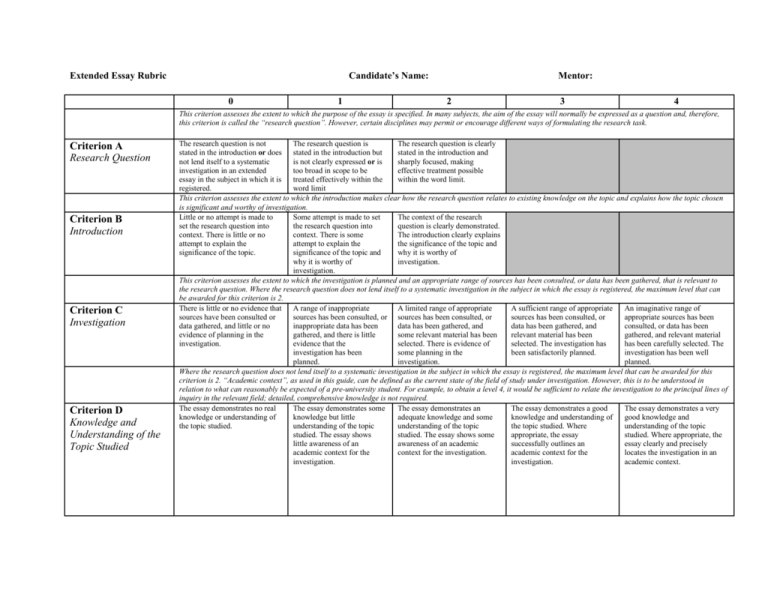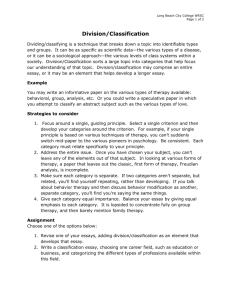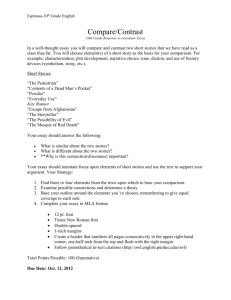CHCI Extended Essay Rubric for mentors
advertisement

Candidate’s Name: Extended Essay Rubric 0 1 Mentor: 2 3 4 This criterion assesses the extent to which the purpose of the essay is specified. In many subjects, the aim of the essay will normally be expressed as a question and, therefore, this criterion is called the “research question”. However, certain disciplines may permit or encourage different ways of formulating the research task. Criterion A Research Question Criterion B Introduction Criterion C Investigation Criterion D Knowledge and Understanding of the Topic Studied The research question is not The research question is The research question is clearly stated in the introduction or does stated in the introduction but stated in the introduction and not lend itself to a systematic is not clearly expressed or is sharply focused, making investigation in an extended too broad in scope to be effective treatment possible essay in the subject in which it is treated effectively within the within the word limit. registered. word limit This criterion assesses the extent to which the introduction makes clear how the research question relates to existing knowledge on the topic and explains how the topic chosen is significant and worthy of investigation. Little or no attempt is made to Some attempt is made to set The context of the research set the research question into the research question into question is clearly demonstrated. context. There is little or no context. There is some The introduction clearly explains attempt to explain the attempt to explain the the significance of the topic and significance of the topic. significance of the topic and why it is worthy of why it is worthy of investigation. investigation. This criterion assesses the extent to which the investigation is planned and an appropriate range of sources has been consulted, or data has been gathered, that is relevant to the research question. Where the research question does not lend itself to a systematic investigation in the subject in which the essay is registered, the maximum level that can be awarded for this criterion is 2. There is little or no evidence that A range of inappropriate A limited range of appropriate A sufficient range of appropriate An imaginative range of sources have been consulted or sources has been consulted, or sources has been consulted, or sources has been consulted, or appropriate sources has been data gathered, and little or no inappropriate data has been data has been gathered, and data has been gathered, and consulted, or data has been evidence of planning in the gathered, and there is little some relevant material has been relevant material has been gathered, and relevant material investigation. evidence that the selected. There is evidence of selected. The investigation has has been carefully selected. The investigation has been some planning in the been satisfactorily planned. investigation has been well planned. investigation. planned. Where the research question does not lend itself to a systematic investigation in the subject in which the essay is registered, the maximum level that can be awarded for this criterion is 2. “Academic context”, as used in this guide, can be defined as the current state of the field of study under investigation. However, this is to be understood in relation to what can reasonably be expected of a pre-university student. For example, to obtain a level 4, it would be sufficient to relate the investigation to the principal lines of inquiry in the relevant field; detailed, comprehensive knowledge is not required. The essay demonstrates no real The essay demonstrates some The essay demonstrates an The essay demonstrates a good The essay demonstrates a very knowledge or understanding of knowledge but little adequate knowledge and some knowledge and understanding of good knowledge and the topic studied. understanding of the topic understanding of the topic the topic studied. Where understanding of the topic studied. The essay shows studied. The essay shows some appropriate, the essay studied. Where appropriate, the little awareness of an awareness of an academic successfully outlines an essay clearly and precisely academic context for the context for the investigation. academic context for the locates the investigation in an investigation. investigation. academic context. Criterion E Reasoned Argument Criterion F application of analytical and evaluative skills appropriate to the subject Criterion G Use of Language Appropriate to the Subject Criterion H Conclusion Criterion I Formal Presentation Criterion J Abstract Criterion K Holistic Judgment This criterion assesses the extent to which the essay uses the material collected to present ideas in a logical and coherent manner, and develops a reasoned argument in relation to the research question. Where the research question does not lend itself to a systematic investigation in the subject in which the essay is registered, the maximum level that can be awarded for this criterion is 2. There is no attempt to develop a There is a limited or There is some attempt to present Ideas are presented in a logical Ideas are presented clearly and in reasoned argument in relation to superficial attempt to present ideas in a logical and coherent and coherent manner, and a a logical and coherent manner. the research question. ideas in a logical and coherent manner, and to develop a reasoned argument is developed The essay succeeds in manner, and to develop a reasoned argument in relation to in relation to the research developing a reasoned and reasoned argument in relation the research question, but this is question, but with some convincing argument in relation to the research question. only partially successful. weaknesses. to the research question. The essay shows no application The essay shows little The essay shows some The essay shows sound The essay shows effective and of appropriate analytical and application of appropriate application of appropriate application of appropriate sophisticated application of evaluative skills. analytical and evaluative analytical and evaluative skills, analytical and evaluative skills. appropriate analytical and skills. which may be only partially evaluative skills. effective. The language used is inaccurate and unclear. There is no effective use of terminology appropriate to the subject. The language used sometimes The language used for the most The language used The language used communicates clearly but part communicates clearly. The communicates clearly. The use communicates clearly and does not do so consistently. use of terminology appropriate of terminology appropriate to the precisely. Terminology The use of terminology to the subject is usually accurate. subject is accurate, although appropriate to the subject is used appropriate to the subject is there may be occasional lapses. accurately, with skill and only partly accurate. understanding. This criterion assesses the extent to which the essay incorporates a conclusion that is relevant to the research question and is consistent with the evidence presented in the essay. Little or no attempt is made to A conclusion is attempted An effective conclusion is provide a conclusion that is that is relevant to the research clearly stated; it is relevant to the relevant to the research question. question but may not be research question and consistent entirely consistent with the with the evidence presented in evidence presented in the the essay. It should include essay. unresolved questions where appropriate to the subject concerned. This criterion assesses the extent to which the layout, organization, appearance and formal elements of the essay consistently follow a standard format. The formal elements are: title page, table of contents, page numbers, illustrative material, quotations, documentation (including references, citations and bibliography) and appendices (if used). The formal presentation is The formal presentation is The formal presentation is The formal presentation is good. The formal presentation is unacceptable, or the essay poor. satisfactory. excellent. exceeds 4,000 words. The requirements for the abstract are for it to state clearly the research question that was investigated, how the investigation was undertaken and the conclusion(s) of the essay. The abstract exceeds 300 words The abstract contains the The abstract clearly states all the or one or more of the required elements listed above but they elements listed above. elements of an abstract (listed are not all clearly stated. above) is missing. The purpose of this criterion is to assess the qualities that distinguish an essay from the average, such as intellectual initiative, depth of understanding and insight. While these qualities will be clearly present in the best work, less successful essays may also show some evidence of them and should be rewarded under this criterion. The essay shows no evidence of The essay shows little The essay shows some evidence The essay shows clear evidence The essay shows considerable such qualities. evidence of such qualities. of such qualities. of such qualities. evidence of such qualities. Grade Boundaries for EE (May 2014) A 29 to 36 B 23 to 28 C 16 to 22 D 8 to 15 E 0 to 7 The Viva Voce Exit Interview The viva voce serves the following purposes: A check on plagiarism and malpractice in general An opportunity to reflect on successes and difficulties in the research process An opportunity to reflect on what has been learned An aid to the supervisor’s report These are suggestions for questions. Mentors may wish to take notes during the interview to help with the supervisor’s report. 1. 2. 3. 4. 5. Has the research question been clearly stated in the introduction, conclusion and abstract? Has the thesis statement been clearly stated in the introduction, conclusion and abstract? Is the EE total word count under 4000 words? Is the abstract complete and under 300 words? Has all of the criteria been included? Does the student fully understand the content submitted? Ask the student to summarize the major arguments of the essay for you. 6. What did you learn about formatting and referencing while doing the EE? 7. Has the EE been submitted to Turn-it-in? What did the originality report indicate? 8. Are you happy with the subject area and topic you selected? Now that you are done, would you change anything that you did? 9. Did you discover anything about yourself or your topic that surprised you? 10. What advice would you pass on to a student just beginning the EE? 11. How do you think the EE process will be helpful to you in your future studies? 12. Is there anything else you would like me to mention in the report? Notes:







